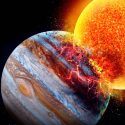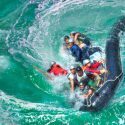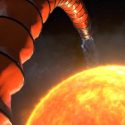A brand new continent has emerged in the middle of the Pacific Ocean. A process that would typically take millions of years happened overnight. How would this disrupt the Earth’s fragile geography?
How would global superpowers deal with a new strategic territory up for grabs? And would this new landmass be good for humanity? Or would it have terrible consequences?
Our planet didn’t always have the continents you know and love. Four billion years ago, as tectonic plates underneath the Earth’s surface slid around, the land on their edges started to rise. These scattered chunks collided over billions of years until they formed the first supercontinent called Rodinia.
Then the land continued to break apart and come back together. Another supercontinent, Pangea was formed. And around 200 million years ago, Pangea began to break apart into the continents you know today.
All those changes happened over millions of years. But if a new continent suddenly emerged in less than 24 hours, how would this disrupt your day-to-day life? You might be surprised to learn that 1067 m (3,500 ft) under the South Pacific is the hidden continent of Zealandia.
Even though Zealandia isn’t officially recognized as an eighth continent, it’s nearly 70% as large as Australia at 5.2 million square km (2 million square mi). But only 6% of this continent sits above sea level.
For a new landmass to be considered a continent, it would need to have a surface area similar to Zealandia. And it would need to be a large, continuous, discrete mass of land, ideally separated by an expanse of water.
The Pacific Ocean has an average depth of 4,000 m (13,000 ft). So, a significant volume of rock would need to be forced upward, shaping the new continent. The plates in this region would shift and collide with an incredible amount of violence. There would be massive earthquakes and volcanic eruptions as the land built up.
The sudden increase in land volume would have a dramatic impact on the already rising sea levels. Current estimates put the world on track for sea levels to rise by 2.5 m (8.2 ft) by 2100. This would only be a drop in the bucket compared to what you would experience if a new continent emerged overnight.
A continent with the surface area of Zealandia would instantly make sea levels rise 40 m (131 ft). Overnight. Massive flooding would occur all over the globe. And low-lying nations such as Bangladesh, Senegal and the Netherlands would disappear. This would have a devastating effect on the lives of millions of people.
And this would just be the beginning. A new continent in the middle of the Pacific would cause massive disruptions to the ocean’s currents. These currents play an essential role in driving our weather systems. They store solar radiation and move heat and moisture around the planet.
This would primarily impact the North Pacific Subtropical Gyre. This is the large system of swirling ocean currents. One of the largest biomes on Earth, it is home to many species of marine animals. A new continent would disrupt the routes many of these animals travel.
The formation of a new continent would also have serious geopolitical ramifications. Oceans are technically viewed as international zones. That means no one country has jurisdiction. If a continent appeared within 22 km (13.6 mi)) of a country’s coastline, that country could make a legitimate claim to ownership.
With all the tectonic violence needed to create this land, most countries would probably not want any part of it. But if this new continent emerged in the middle of the Pacific Ocean, it would be more challenging to decide who owns it.
It would be a huge international debate that could create high tension among powerful nations. The United Nations, the essential governing body over the oceans, would have to oversee this significant political event. If you were looking to move to this very new land, it would need to be habitable first. The continent would emerge from the sea completely barren. It would be all rock with no soil or even freshwater source.
It could become a popular tourism area or even a radical solution for storing toxic waste. But we live in a highly connected world, where even small, incremental changes can lead to disaster.
Sources
- “How continents are formed?” archive.telanganatoday.com
- “Pangea | Definition, Map, History, & Facts”. 2021. Encyclopedia Britannica.
- “In The Future, Earth Will Have Just One Continent. It Might Look Like This”. Mattias Green, The Conversation. 2021. Sciencealert.
- “The Continents: Land Area -Zoomschool.Com”. 2021. enchantedlearning.com.
- “What Is A Continent – Universe Today”. 2010. Universe Today.
- “Quick Facts On Ice Sheets | National Snow And Ice Data Center”. 2021. nsidc.org.




























What If! You just read my mind! I am sponsoring a project named Kelton which will 3D print a Texas-sized island in the Pacific just east of Guam (location idk).